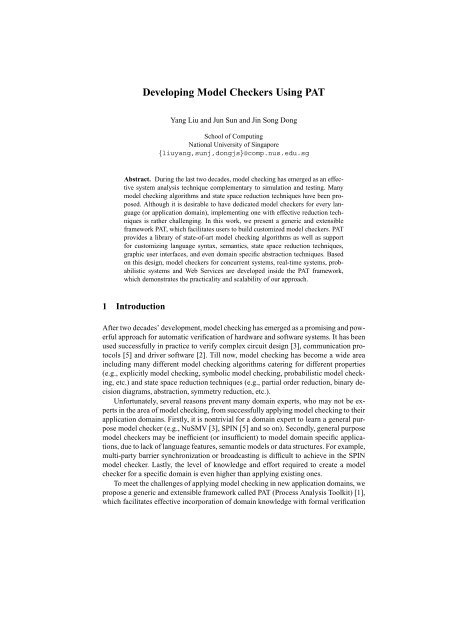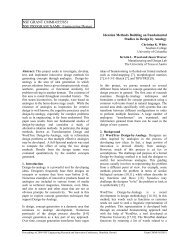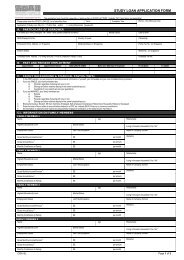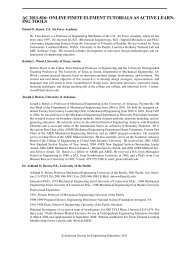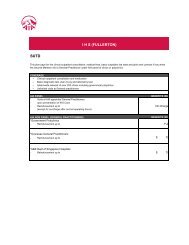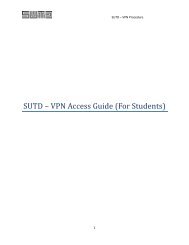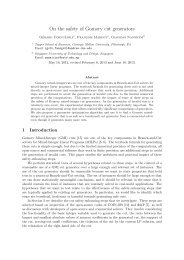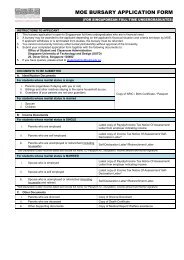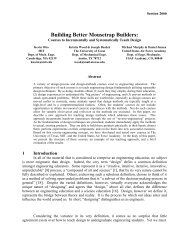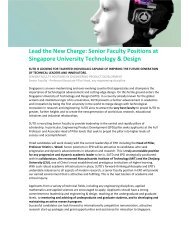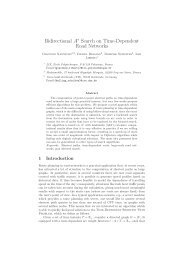Developing Model Checkers Using PAT
Developing Model Checkers Using PAT
Developing Model Checkers Using PAT
You also want an ePaper? Increase the reach of your titles
YUMPU automatically turns print PDFs into web optimized ePapers that Google loves.
<strong>Developing</strong> <strong>Model</strong> <strong>Checkers</strong> <strong>Using</strong> <strong>PAT</strong>Yang Liu and Jun Sun and Jin Song DongSchool of ComputingNational University of Singapore{liuyang,sunj,dongjs}@comp.nus.edu.sgAbstract. During the last two decades, model checking has emerged as an effectivesystem analysis technique complementary to simulation and testing. Manymodel checking algorithms and state space reduction techniques have been proposed.Although it is desirable to have dedicated model checkers for every language(or application domain), implementing one with effective reduction techniquesis rather challenging. In this work, we present a generic and extensibleframework <strong>PAT</strong>, which facilitates users to build customized model checkers. <strong>PAT</strong>provides a library of state-of-art model checking algorithms as well as supportfor customizing language syntax, semantics, state space reduction techniques,graphic user interfaces, and even domain specific abstraction techniques. Basedon this design, model checkers for concurrent systems, real-time systems, probabilisticsystems and Web Services are developed inside the <strong>PAT</strong> framework,which demonstrates the practicality and scalability of our approach.1 IntroductionAfter two decades’ development, model checking has emerged as a promising and powerfulapproach for automatic verification of hardware and software systems. It has beenused successfully in practice to verify complex circuit design [3], communication protocols[5] and driver software [2]. Till now, model checking has become a wide areaincluding many different model checking algorithms catering for different properties(e.g., explicitly model checking, symbolic model checking, probabilistic model checking,etc.) and state space reduction techniques (e.g., partial order reduction, binary decisiondiagrams, abstraction, symmetry reduction, etc.).Unfortunately, several reasons prevent many domain experts, who may not be expertsin the area of model checking, from successfully applying model checking to theirapplication domains. Firstly, it is nontrivial for a domain expert to learn a general purposemodel checker (e.g., NuSMV [3], SPIN [5] and so on). Secondly, general purposemodel checkers may be inefficient (or insufficient) to model domain specific applications,due to lack of language features, semantic models or data structures. For example,multi-party barrier synchronization or broadcasting is difficult to achieve in the SPINmodel checker. Lastly, the level of knowledge and effort required to create a modelchecker for a specific domain is even higher than applying existing ones.To meet the challenges of applying model checking in new application domains, wepropose a generic and extensible framework called <strong>PAT</strong> (Process Analysis Toolkit) [1],which facilitates effective incorporation of domain knowledge with formal verification
Fig. 1. <strong>PAT</strong> Architectureusing model checking techniques. <strong>PAT</strong> is a self-contained environment to support composing,simulating and reasoning of system models. It comes with user friendly interfaces,a featured model editor and an animated simulator. Most importantly, <strong>PAT</strong> implementsa library of model checking techniques catering for checking deadlock-freeness,divergence-freeness, reachability, LTL properties with fairness assumptions [13], refinementchecking [11] and probabilistic model checking. Advanced optimization techniquesare implemented in <strong>PAT</strong>, e.g., partial order reduction, process counter abstraction[16], bounded model checking [14], parallel model checking [8] and probabilisticmodel checking. <strong>PAT</strong> supports both explicit state model checking and symbolic modelchecking (based on BDD or SAT solver). We have used <strong>PAT</strong> to model and verify a varietyof systems [6]. Previously unknown bugs have been discovered [7]. The experimentresults show that <strong>PAT</strong> is capable of verifying systems with large number of states andoutperforms the state-of-the-art model checkers in some cases.2 Architecture Overview<strong>PAT</strong> was initially designed to support a unified way of model checking under fairness[13]. Since then, <strong>PAT</strong> has been extended significantly and completely re-designed.We have adopted a layered design to support analysis of different systems/languages,which can be implemented as plug-in modules. Fig. 1 shows the architecture designof <strong>PAT</strong>. For each supported domain (e.g., distributed system, real-time system, serviceoriented computing and so on), a dedicated module is created in <strong>PAT</strong>, which identifiesthe (specialized) language syntax, well-formness rules as well as formal operationalsemantics. For instance, the CSP module is developed for the analysis of concurrentsystem modeled in CSP# [12]. The operational semantics of the target language translatesthe behavior of a model into LTS (Labeled Transition Systems) 1 at runtime. LTSserves as an implicitly shared internal representation of the input models, which canbe automatically explored by the verification algorithms or used for simulation. To performmodel checking on LTSs, the number of states in the LTSs needs to be finite. Forsystems with infinite behavior (e.g., real time clocks or infinite number of processes),1 To be precise, it is a Markov Decision Process when probabilistic choices are involved.
abstraction techniques are needed. Examples of abstraction techniques include data abstraction,process counter abstraction, clock zone abstraction, environment abstraction,etc. The verification algorithms perform on-the-fly exploration of the LTSs. If a counterexampleis identified during the exploration, then it can be animated in the simulator.This design allows new modules to easily be plugged in and out, without recompilingthe core system, and the developed model checking algorithms (mentioned in Section1) to be shared by all modules. This design achieves extensible architecture as well asmodule encapsulation. We have successfully applied this framework in development offour different modules, each of which targets a different domain. 1). The concurrent systemmodule is designed for analyzing general concurrent systems using a rich modelinglanguage CSP# [12], which combines high-level modeling operators with programmerfavoredlow-level features. 2). The real-time system module supports analysis of realtimesystems with compositional behavioral patterns (e.g. timeout, deadline) [15].Instead of explicitly manipulating clock variables, time related constructs are designedto build on implicit clocks and discretized using clock zone abstraction [15]. 3). TheWeb Services (WS) module offers practical solutions to the conformance checking andprototype synthesis between WS Choreography and WS Orchestration. 4). The probabilisticmodule supports the modeling and verification of systems exhibiting random orprobabilistic behavior.3 Manufacturing <strong>Model</strong> <strong>Checkers</strong>In this section, we discuss how to create a customized model checker for a new domainusing the <strong>PAT</strong> framework with the help of its predefined APIs, examples and softwarepackages. A domain often has its specific model description language. It is desirablethat the domain experts can input their models using their own languages. There arethree different ways of supporting a new language in <strong>PAT</strong>.– The easiest way is to create a syntax rewriter from the domain specific languageto an existing language. This is only recommended if the domain language is lessexpressiveness than the existing languages. For example, we have developed translatorsfrom Promela/UML state diagram to CSP#. Comparing with other tools, programminga translator is straightforward in <strong>PAT</strong>. Because <strong>PAT</strong> has open APIs forits language constructs, users only need to generate the language constructs objectsusing these APIs, which can guarantee that the generated syntax is correct. This approachis simple and requires little interaction with <strong>PAT</strong> codes. However, translationmay not be optimal if special domain specific language features are present. Furthermore,reflecting analysis results back to the domain model is often non-trivial.– The second way is to extend an existing module if the input languages are similarand yet with a few specialized features. For example, the probabilistic module isdesigned to extend the concurrent system module with one additional languagefeature, i.e., probabilistic choices. Knowledge about existing modules is requiredand a new parser may be created for the extended language features.– The third way is to create a new module in <strong>PAT</strong>. In this case, users firstly need todevelop a parser according to the syntax. The parser should generate a model con-
sisting of ASTs of language construct classes, which encode their operational semantics.Abstract classes 2 for system states, language construct classes and systemmodel are pre-defined in <strong>PAT</strong> with (abstract) signature methods for communicationswith verification algorithms and user interface interactions. Users only need todevelop concrete classes in the new module by inheriting the abstract classes. Thisapproach is the most complicated compared with the first two. Nevertheless, thisapproach gives the most flexibility and efficiency. It is difficult to quantify the effortrequired to build a high-quality module in <strong>PAT</strong>. Experiences suggest that a newmodule can be developed in months or even weeks in our team. This approach isfeasible for domain experts who have only the basic knowledge on model checking.This is because model checking algorithms and state space reduction techniques areseparated from the syntax and semantics of the modeling language.It is possible that a domain may have its own specialized properties to verify and specifiedmodel checking algorithms. Our design allows seamless integration of new modelchecking algorithm and optimization techniques by inheriting base assertion class andimplementing its API. Furthermore, supporting functions, like LTL to Büchi, Rabin,Streett automata conversion, are provided in <strong>PAT</strong> to ease the development of new algorithms.For instance, we have successfully developed the algorithms for divergencechecking, timed refinement checking in real-time system module and new deadlockand probabilistic reachability checking. Furthermore, <strong>PAT</strong> facilitates customized stateencoding by defining the interfaces methods in system state class. Different verificationalgorithms using different state encoding are developed. Currently, <strong>PAT</strong> supports explicitlystate encoding using hash table and symbolic state representation using BDD.The choice of the encoding is made by the users in the user interface at runtime.4 Performance Evaluation<strong>PAT</strong> is capable of verifying systems with large number of states and outperforms thestate-of-the-art model checkers in some cases. Experimental results for LTL verificationunder fairness and refinement checking are presented in Fig. 2 as an indication of oureffort on optimizing the model checking algorithms.The table on the left shows the verification results on recently developed leaderelection protocols with different topologies, where the correctness (modeled using LTLformula) of these protocols requires different notions of fairness. Firstly, <strong>PAT</strong> usuallyfinds counterexamples quickly. Secondly, verification under event-level strong fairness(ESF) is more expensive than verification with no fair, event-level weak fairness (EWF)or strong global fairness (SGF). Lastly, <strong>PAT</strong> outperforms SPIN for the fairness verifications.SPIN increases the verification time under weak fairness by a factor that islinear in the number of processes. SPIN has no support for strong fairness or SGF. <strong>PAT</strong>offers comparably better performance on verification under weak fairness and makes itfeasible to verify under strong fairness or SGF.In addition to temporal logic verification, <strong>PAT</strong> offers capability of refinement checking(i.e. language inclusion checking). The table on the right shows the performance us-2 Detailed explanation and usages of the abstract classes are available in <strong>PAT</strong>’s user manual.
<strong>Model</strong> Size EWF ESF SGFRes. <strong>PAT</strong> SPIN Res. <strong>PAT</strong> Res. <strong>PAT</strong>LE C 5 Yes 4.7 35.7 Yes 4.7 Yes 4.1LE C 6 Yes 26.7 229 Yes 26.7 Yes 23.5LE C 7 Yes 152 1190 Yes 152 Yes 137LE C 8 Yes 726 5720 Yes 739 Yes 673LE T 7 Yes 1.4 7.6 Yes 1.4 Yes 1.4LE T 9 Yes 10.2 62.3 Yes 10.2 Yes 9.6LE T 11 Yes 68.1 440 Yes 68.7 Yes 65.1LE T 13 Yes 548 3200 Yes 573 Yes 529LE OR 3 No 0.2 0.3 No 0.2 Yes 11.8LE OR 5 No 1.3 8.7 No 1.8 - -LE OR 7 No 15.9 95 No 21.3 - -LE R 4 No 0.3
approach takes one step further to allow the development of fully customized modelcheckers. Furthermore, the supported libraries in <strong>PAT</strong> offer user advanced model checkingtechniques like real-time verification and probabilistic model checking, which areabsent in Bogor and LTSA.Compared to [13], we redesigned the system to separate the GUI, verification algorithmsand modeling languages. Each modeling language is encapsulated into a standalonepackage, which makes the system extensible. Furthermore, we have added thesupport for real-time and probabilistic systems. The enhancement is dramatic. Startingfrom 2007, <strong>PAT</strong> has come to a stable stage with solid testing and various applications.More than 60 built-in examples and hundreds of test cases are embedded in <strong>PAT</strong>. <strong>PAT</strong>has been used by a number of institutions as a research or educational tool. The mainobjective of <strong>PAT</strong> is to bring sophisticated model checking techniques to a variety ofdomains. The existing modules and on-going modules under development have shownthe usefulness and feasibility of this framework.References1. <strong>PAT</strong>: Process Analysis Toolkit. http://pat.comp.nus.edu.sg/.2. T. Ball, B. Cook, V. Levin, and S. K. Rajamani. SLAM and Static Driver Verifier: TechnologyTransfer of Formal Methods inside Microsoft. In IFM 2004, pages 1–20. Springer, 2004.3. A. Cimatti, E. M. Clarke, E. Giunchiglia, F. Giunchiglia, M. Pistore, M. Roveri, R. Sebastiani,and A. Tacchella. NuSMV 2: An OpenSource Tool for Symbolic <strong>Model</strong> Checking. InCAV 2002, pages 359–364, 2002.4. M. B. Dwyer, J. Hatcliff, M. Hoosier, and Robby. Building Your Own Software <strong>Model</strong>Checker <strong>Using</strong> the Bogor Extensible <strong>Model</strong> Checking Framework. In CAV 2005, pages148–152, 2005.5. G. J. Holzmann. The SPIN <strong>Model</strong> Checker: Primer and Reference Manual. Wiley, 2003.6. Y. Liu, W. Chen, Y. A. Liu, and J. Sun. <strong>Model</strong> Checking Lineariability via Refinement. InFM 2009, pages 321–337, 2009.7. Y. Liu, J. Pang, J. Sun, and J. Zhao. Efficient Verification of Population Ring Protocols in<strong>PAT</strong>. In TASE 2009, pages 81–89, 2009.8. Y. Liu, J. Sun, and J. S. Dong. Scalable Multi-Core <strong>Model</strong> Checking Fairness EnhancedSystems. In ICFEM 2009, pages 426–445, Dec 2009.9. J. Magee and J. Kramer. Concurrency: State <strong>Model</strong>s & Java Programs. Wiley, 1999.10. A. W. Roscoe. <strong>Model</strong>-checking CSP. A classical mind: essays in honour of C. A. R. Hoare,pages 353–378, 1994.11. J. Sun, Y. Liu, and J. S. Dong. <strong>Model</strong> Checking CSP Revisited: Introducing a Process AnalysisToolkit. In ISoLA 2008, pages 307–322. Springer, 2008.12. J. Sun, Y. Liu, J. S. Dong, and C. Q. Chen. Integrating Specification and Programs for System<strong>Model</strong>ing and Verification. In TASE 2009, pages 127–135. IEEE Computer Society, 2009.13. J. Sun, Y. Liu, J. S. Dong, and J. Pang. <strong>PAT</strong>: Towards Flexible Verification under Fairness.In CAV 2009, pages 702–708, Grenoble, France, June 2009.14. J. Sun, Y. Liu, J. S. Dong, and J. Sun. Bounded <strong>Model</strong> Checking of Compositional Processes.In TASE 2008, pages 23–30. IEEE Computer Society, 2008.15. J. Sun, Y. Liu, J. S. Dong, and H. H. Wang. Verifying Stateful Timed CSP using ImplicitClocks and Zone Abstraction. In ICFEM 2009, pages 581–600, Dec 2009.16. J. Sun, Y. Liu, A. Roychoudhury, S. Liu, and J. S. Dong. Fair <strong>Model</strong> Checking of ParameterizedSystems. In FM 2009, pages 123–139, 2009.


